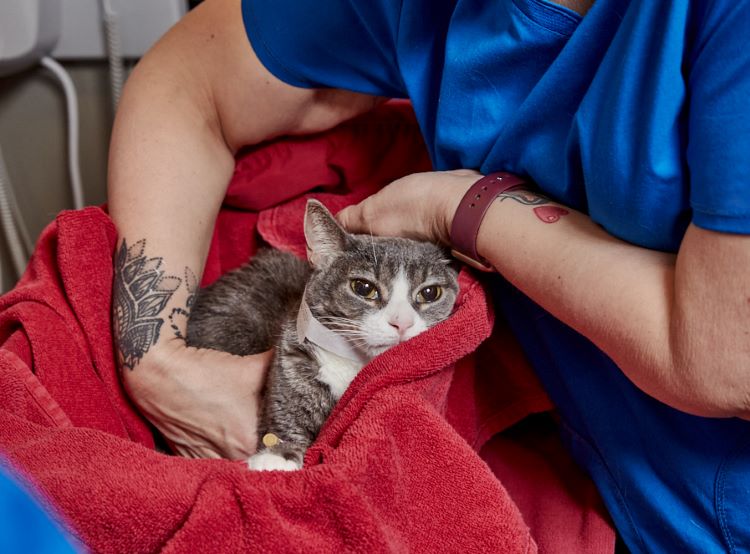Ready to help treat your pet to a healthy life?
Is a Pet Savings Account a Better Option than Pet Insurance?
By : Brianna Gunter | Published Apr 24, 2025

As all pet parents find out eventually, pet medical expenses aren’t exactly cheap. And if your dog or cat winds up getting in an accident, coming down with a sudden illness, or experiences any kind of health surprise, their treatment costs can add up fast. But while pet health costs have grown more expensive over the years, there are fortunately more options than ever before to help pay for them. Pet insurance is the obvious go-to, but some pet owners are opting to set aside money in a pet savings account instead.
But is this really the better choice? Since you can’t see into the future and know what kinds of medical emergencies or chronic conditions will come your pet’s way, you’ll need to evaluate your options upfront.
What is a pet savings account?
A pet savings account is simply a financial account where you save up money specifically for your pet’s care. Sometimes types of savings accounts designed for this purpose are offered at banks or credit unions.
Nevertheless, going with one of these options isn’t necessary. Likewise, though the term “savings account” is often used, it doesn’t actually have to be a savings account in the traditional sense — it’s just you actively setting aside money for your pet.
Effectively, pet savings accounts are just another way to try to accommodate any future unexpected veterinary costs into your financial plans. None of these options are designed to fully cover the cost of your pet’s medical care, but they can be useful depending on how much is saved up. The tricky part here is that it’d be easier to decide how to budget (that is, how much to save up) for your pet’s health expenses if you knew exactly what they were going to be throughout their lifetime.
Pros and cons of a pet savings account
Before you decide to start a savings account for your pet’s health, it’s a good idea to weigh the pros and cons:
Pro: You may feel more in control
It’s your money, so you make the decisions regarding how much is paid out and when for your pet’s health care. You don’t have to navigate factors like claims decisions and pre-existing conditions. You also will be paying your veterinarian directly instead of filing a claim.
Con: You won’t get much financial help
While pet savings accounts can sound like a simple solution, it’s important to remember that you will still be the one paying for your pet’s veterinary care. While pet insurance pays out your provider’s money so you don’t have to handle your pet’s medical expenses all on your own, a pet savings account is simply your own money saved up over time.
You could consider a high-yield savings account to help mitigate this, but these come with their own sets of pros and cons.
Pro: You can earn interest
If you set up an actual savings account with a financial institution, one pro is that you can earn interest on your deposits. The downside is, of course, that this interest builds up slowly and isn’t going to be a significant portion of your savings — especially if you aren’t actively depositing large sums every month. Still, every bit counts when it comes to your pet’s health.
Con: It might not be of much help in the short term
As mentioned, interest typically builds up slowly in savings accounts. And that’s if you’ve even set up an account that earns interest at all. And, because it’s your own money being saved up, it could take a long time to build up an amount that would be of significant help for your pet’s medical costs.
The whole point of having a pet savings account is to enable you to be able to pay for emergencies and other surprise veterinary expenses. Since those situations can happen at any time, however, your pet may wind up needing care before you have saved up enough to afford it.

Understanding pet insurance
Unlike a pet savings account, pet insurance relies on external help for your pet’s unexpected medical costs. As the name suggests, it’s a type of health coverage that helps pet owners manage the cost of veterinary emergencies and other conditions. Similar to human health insurance, it requires a monthly premium in exchange for covering a designated portion of eligible medical expenses. While there are different types of pet insurance providers and plans, many cover costs related to:
- Accidents and emergency care
- Illnesses
- Surgeries and sometimes hospital stays
- Diagnostic tests like x-rays, blood work, ultrasounds, etc.
- Chronic conditions
- Medications
Keep in mind though that coverage varies greatly between providers. The items listed above may not be covered in all situations or at all by some insurers, so it’s important to read the fine print.
While there’s no telling how much your pet will actually need it in their lifetime, pet insurance can protect against major financial strain and help you make care decisions based on need rather than cost.
Pros and cons
As with pet savings accounts, there are some pros and cons of pet insurance to consider:
Pro: Expensive veterinary treatments can become more affordable
The fundamental purpose of a pet health insurance plan is to help pay for the costs of veterinary care. Unexpected care costs — whether accidents, sudden illnesses, or chronic health conditions — can quickly add up and may far exceed your regular budget.
Sadly, surveys have found that over half of pet owners have skipped veterinary care or not followed through with recommended treatments due to cost. But with pet insurance helping to cover eligible costs, you can focus more on getting the treatment that’s actually best for your pet and spend less time worrying about how to pay for it.
Con: Not everything is covered
Only eligible costs are covered under pet insurance, which primarily means only conditions that are considered non-preventable and are not pre-existing. This means that if your pet had a previous health condition before you signed up for pet insurance, that condition will not be covered going forward.
It’s also worth noting that some pet insurance companies limit coverage for certain breeds. However, other providers like Trupanion do not impose breed restrictions.
Pro: Value throughout your pet’s lifetime
With the right pet insurance coverage, life-saving care for your pet is more attainable. And, unlike a pet savings account, it doesn’t matter whether they get sick within months or many years down the line. You don’t have to wait to save up your own finances, enabling you to say “yes” to the treatment your pet needs, when they need it.
Now, some pet insurance companies do have limits on how much they’ll pay out for each pet and/or each eligible health condition. But if you go with a provider like Trupanion that doesn’t imposes these payout caps, you don’t have to worry about that.
Con: You may have to wait for reimbursement
The typical pet insurance model requires you to pay your veterinary bill upfront and then file a claim with your insurer and wait for reimbursement. And, depending on how long it takes to review and process your claim, you could find yourself waiting anywhere from days to months to get reimbursed.
The good news here is that not all pet insurance providers have lengthy wait times. Trupanion, for example, processes most claims within 24 hours. And if your veterinarian is set up for Trupanion’s VetDirect PayTM, you can have your vet bills paid directly and don’t even have to worry about filing your own claim and waiting.
Pro: You may get extra perks
Some pet insurance providers offer special discounts to their members as part of a more holistic approach to pet care and wellness. For example, Trupanion offers “truTreats,” which are various discounts for things like pet sitting services and pet health tracking devices.
These perks shouldn’t be the only reason you decide to sign up for pet insurance, of course, but they can nevertheless be a nice addition to quality coverage for your dog or cat.

Deciding which one is right for you (and your pet)
Even knowing the pros and cons of pet savings accounts vs pet insurance, it can still be tricky to know which choice is best for you and your pet. It’s a good idea to take a close look at your finances as well as your personal risk tolerance.
A good way to do this is by considering potential scenarios. Say your pet gets into an accident a month from now and needs immediate veterinary care that costs thousands of dollars — would you be able to handle it with ease from your own finances? Sure, you may not like the idea of paying a monthly pet insurance premium. But if you’re concerned about expensive veterinary emergencies and would struggle to pay a big medical bill out of pocket, pet insurance can be a worthwhile investment.
On the other hand, if you wouldn’t bat an eye at any sudden emergency but would just like some extra money set aside for your pet’s health years from now, then opting for a pet savings account could be a good choice.
Can you get both a pet savings account and a pet insurance plan?
The good news is that you don’t have to choose one or the other for your pet! A lot of people decide to get both a pet insurance plan and save up a fund for their pet’s care on the side. This way, you get the benefits of both:
- Pet insurance for emergencies and health surprises that could pop up at any time, whether you’re prepared or not.
- Pet savings account earmarked for your pet’s routine health expenses and anything not covered by your pet insurance plan.
Still mulling it over? Follow these tips to choose the best pet insurance coverage for you and your pet.
